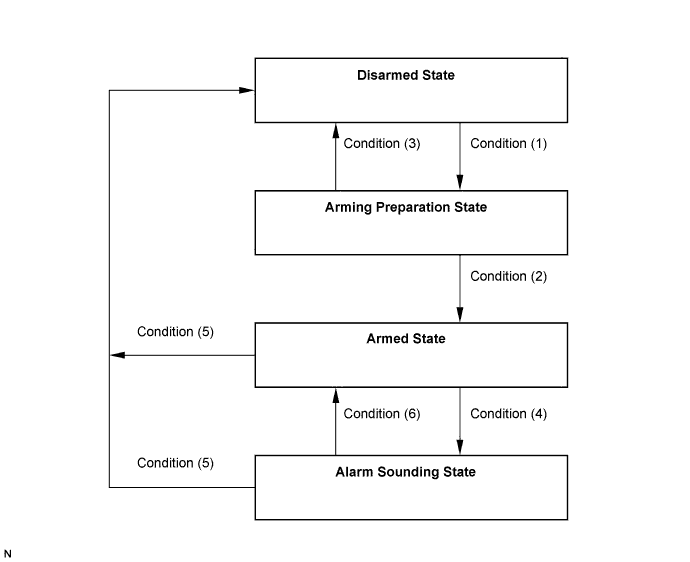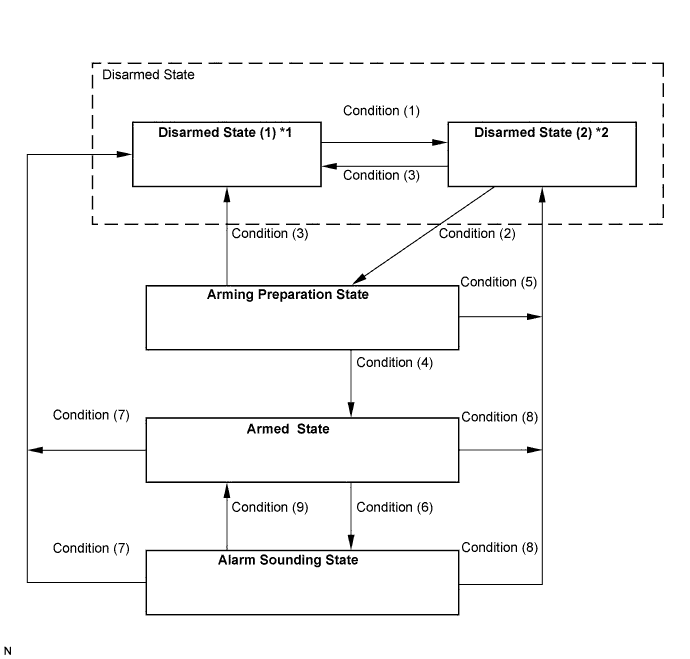Theft Deterrent System (For Sedan) -- System Description |
| OUTLINE OF THEFT DETERRENT SYSTEM |
When any attempt is made to forcibly enter the vehicle, open the engine hood or unlock any door without using a key, or when the battery terminals are disconnected and then reconnected, this system causes the vehicle horn and security horn to sound, the interior light to light up, and the hazard warning lights, taillights and headlights to flash, in order to deter break-in and theft.
The theft deterrent system has two arming modes; Active and Passive. Active arming mode allows the theft deterrent system to activate normally. Passive arming mode is used for the servicing. The Techstream allows the theft deterrent system to switch between Active and Passive.
(YARIS_NCP93 RM0000012RO00QX.html)Each mode has 4 states; a disarmed state, an arming preparation state, an armed state and an alarm sounding state.
Disarmed state:
- The alarm function is not operating.
- The theft deterrent system is not operating.
- The alarm function is not operating.
Arming preparation state:
- The state before the system goes into the armed state.
- The theft deterrent system is not operating.
- The state before the system goes into the armed state.
Armed state:
- The theft deterrent system is operating.
- The theft deterrent system is operating.
Alarm sounding state:
- The alarm function is operating.
- Alarm time:
- Approximately 57 seconds.
Alarm form manifestation and duration: Alarm Form Headlight Blinks
(approximately 0.4 seconds cycles)Taillight Blinks
(approximately 0.4 seconds cycles)Hazard Warning Light Blinks (Cycle of flasher relay) Interior Light Illuminates Vehicle Horn Sounds
(approximately 0.4 seconds cycles)Security Horn Sounds
(approximately 0.4 seconds cycles)Alarm Duration Approximately 57 seconds - The alarm function is operating.
| ACTIVE ARMING MODE |
- HINT:
- Active arming mode starts the alarm control immediately after the doors are locked.
- This system activates as described in the diagram below when one item for each condition is met.
Active arming mode

*: Only for vehicles with transmitter.Condition Item Condition (1) (No key in ignition key cylinder) - All doors locked using key when all doors, engine hood and luggage compartment door closed.
- Any open door closed and locked when all other doors locked, and engine hood and luggage compartment door closed.
- All doors locked by using transmitter LOCK switch*.
Condition (2) - After condition (1) met, 30 seconds allowed to enter armed state.
Condition (3) One of following operations performed within 30 seconds of entering arming preparation state: - Any door unlocked.
- Any door opened.
- Engine hood opened.
- Luggage compartment door opened.
- Key inserted into ignition key cylinder.
- Battery reconnected.
Condition (4) One of following operations performed in armed state: - Any door opened.
- Any door unlocked without using key or transmitter*.
- Engine hood opened.
- Luggage compartment door opened without using key.
- Battery reconnected.
- Ignition switch turned on without using key.
Condition (5) One of following operations performed in alarm sounding state or armed state: - Any door unlocked or luggage compartment door opened using key.
- Key inserted into ignition key cylinder and 2 seconds elapse since engine start.
- All doors unlocked by wireless operation*.
Condition (6) - After approximately 57 seconds, alarm stops sounding and system returns to armed state.
- All doors locked using key when all doors, engine hood and luggage compartment door closed.
| PASSIVE ARMING MODE |
- HINT:
- Passive arming mode starts the alarm control after the key is removed from the ignition key cylinder and the doors are closed.
- During passive arming mode, the theft deterrent system goes into the armed state even if the doors are not locked.
- Even if the theft deterrent system detects that a door is opened during passive arming mode, the system does not go into the alarm sounding state immediately because an entry delay time is set.
- If either of the following conditions is met during passive arming mode, the theft deterrent system switches to active arming mode.
- With all the doors and the engine hood closed, all the doors are locked by the key operation.
- With the engine hood closed and all the doors locked with any door still open, the open door is closed.
- This system activates as described in the diagram below when one item for each condition is met.
Passive arming mode

- *1: Disarmed state (1) is the normal disarmed state.
- *2: Disarmed state (2) is set from either the disarmed state (1) or the arming preparation state.
*1: Only for vehicles with transmitter.Condition Item Condition (1) - With ignition switch OFF, any door opened and key removed from ignition key cylinder.
Condition (2) - Engine hood, all doors and luggage compartment door closed.
Condition (3) One of following operations performed in arming preparation state or disarmed state (2): - Key inserted into ignition key cylinder.
- Battery reconnected.
- Any door unlocked using key.
- All doors unlocked using transmitter UNLOCK switch*1.
Condition (4) - Approximately 30 seconds allowed to elapse in arming preparation state.
Condition (5) - Any door, engine hood or luggage compartment door opened.
Condition (6) One of following operations performed in armed state: - Any door opened and entry delay time (see Entry Delay Function) allowed to elapse.
- Engine hood opened.
- Luggage compartment door opened without using key.
- Battery reconnected.
- Ignition switch turned on without using key.
Condition (7) One of following operations performed in armed state or alarm sounding state: - All doors unlocked using transmitter UNLOCK switch*1.
- Driver door or passenger door unlocked using key*2.
- Key inserted into ignition key cylinder and 2 seconds elapse since engine start.
Condition (8) - Luggage compartment door opened using key.
Condition (9) - After approximately 57 seconds, alarm stops sounding and system returns to armed state.
*2: System does not return to disarmed state if the luggage compartment door key cylinder is turned to the unlock position using a key.- *1: Disarmed state (1) is the normal disarmed state.
| ALARM MEMORY FUNCTION |
If the alarm is set off (tampering is detected) while the theft deterrent system is armed, the alarm memory function records it. Whenever the theft deterrent system is canceled, the alarm memory function causes the taillights to light up for 2 seconds in order to indicate that the alarm has been set off.
Conditions of the alarm memory function that cause the taillights to light up:
When the theft deterrent system has entered the alarm sounding state (tampering has been detected), the taillights light up for 2 seconds if either of the following conditions is met.- Switched to the disarmed state from the armed state during active arming mode.
- Switched to the disarmed state (1) from the armed state during passive arming mode.
- HINT:
- Active arming mode: See ACTIVE ARMING MODE.
- Passive arming mode: See PASSIVE ARMING MODE.
- Switched to the disarmed state from the armed state during active arming mode.
| SECURITY INDICATOR OUTPUT |
The theft warning ECU outputs a signal to light up the security indicator, according to the state of the theft deterrent system. However, some of the actual lighting conditions of the security indicator are different from the output signals of the theft warning ECU.
Output: Theft Deterrent System Condition* Security Indicator Output Signals from Theft Warning ECU Actual Lighting Condition Disarmed state (1), (2) OFF OFF (immobiliser system unset)
BLINKING (immobiliser system set)Arming preparation state ON ON Armed state
(During entry delay time)BLINKING
(ON)BLINKING
(ON)Alarm sounding state ON ON Blinking cycle: Time Security Indicator 0.2 seconds ON 1.8 seconds OFF - HINT:
- *: The above condition is common to both active arming mode and passive arming mode.
- When the immobiliser system is set, the security indicator blinks in both the disarmed state and the armed state, due to the output signals from the immobiliser system.
| ENTRY DELAY FUNCTION |
When any door is opened while all the doors are closed during passive arming mode, the entry delay time starts. If the switch condition (7) or (8) (see PASSIVE ARMING MODE) is met during the entry delay time, the theft deterrent system will not set off the alarm. However, if the switch condition (7) or (8) is not met, the theft deterrent system will recognize it as a theft and set off the alarm.

- HINT:
- The entry delay time can be selected from among 0, 14, 30 seconds by customizing the setting.